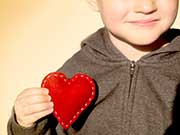|
|
 |
|
The views expressed on this page are soley
those of the author and do not
necessarily represent the views of County
News Online
|
 |
Teachable Moments
Know! To Give
and Receive the Gift of Kindness
Tis the season for giving; and among the greatest gifts one can give to
another is kindness. It need not cost a thing. One single act of
kindness has the potential of inspiring others and creating a rippling
effect that keeps on giving. Research shows that we as human beings are
hard-wired to be kind, some people more than others. But even for those
students who are not the most loving or kindest of creatures at this
stage in development, there is hope. Research shows that this character
trait—which many believe is the key to happiness and success—can be
taught and nurtured as well. It’s critical to role model kindness in
the classroom daily and teach your students how to be the best versions
of themselves that they can be.
The bonus of kindness is that the receiver is not the only one to reap
the benefits. The giver stands to benefit in a number of ways,
including:
Increased feelings of happiness and satisfaction.
Decreased feelings of stress and depression.
Increased acceptance among peers and a greater sense of belonging.
Improved self-esteem and self-worth.
Enhanced immune system and ability to concentrate.
Greater sense of gratitude.
Some of these positive effects stem from the release of endorphins
(feel-good hormones secreted within the brain and nervous system) and
the increased production of serotonin (a naturally occurring chemical
in the brain that has a calming, mood regulating, and anti-anxiety
effect). These chemical releases may occur when a gift of kindness is
given or received. But even observing an act of kindness may benefit
with a rise in serotonin levels—and therefore experience feelings of
increased energy, followed by calmness and serenity. Whether you’re a
giver, receiver, or witness—kindness becomes a win-win-win situation.
Furthermore, when youth experience greater feelings of self-worth,
self-esteem, belonging, connectedness, and an overall increased sense
of well-being, they are at reduced risk for engaging in risky
behaviors, like drinking, smoking, and using other drugs.
The significance and value of kindness is immeasurable. How can you
foster it in your students? Aside from role modeling, you can encourage
them to take action and extend kindness to others. Here are some simple
but powerful ways to be kind:
Give someone a genuine compliment.
Talk to someone new at school.
Write a note to let someone know they are loved.
Randomly hug your parents and let them know you appreciate them.
Deliver a surprise basket of cookies to a neighbor.
Say thank you—a lot—and really mean it.
Hold the door for someone.
Invite someone to join you and your friends at your lunch table.
Shovel an elderly person’s drive—without anything in return.
Help someone clean up an embarrassing spill.
Look people in the eyes, smile, and say “hello” - often
When someone expresses genuine care for another, no matter how simple
or elaborate, it is a gift of kindness. There is no limit to the number
of ways youth can be kind, in this giving season and beyond. We must
teach them through our words and more importantly our actions that they
must keep their eyes and hearts open and seize the many opportunities
around them to extend kindness.
|
|
|
|

